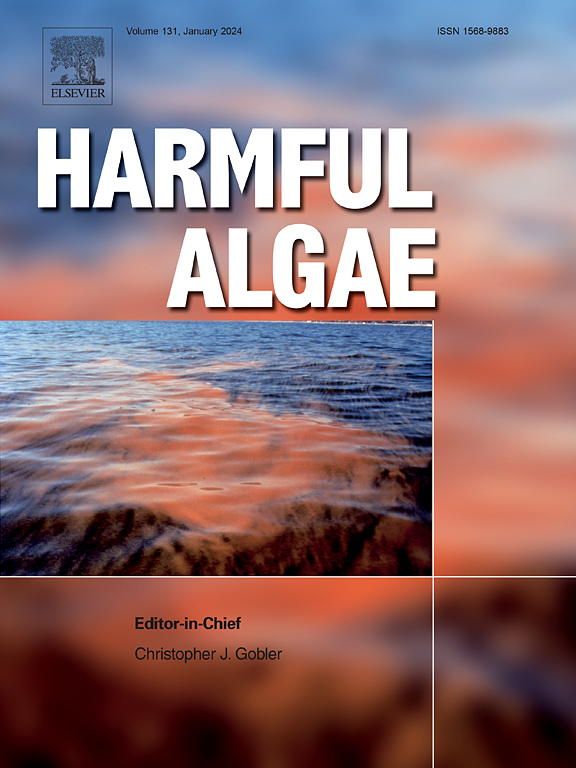World's largest oligotrophic Lake Baikal: Concerns about cyanobacterial blooms and potential microcystin producers along the littoral zone
IF 4.5
1区 生物学
Q1 MARINE & FRESHWATER BIOLOGY
引用次数: 0
Abstract
Toxic cyanobacterial blooms are great challenge for water safety globally. Previous studies mainly focused on this issue in eutrophic lakes, but associated knowledge in oligotrophic lakes is quite scarce. Lake Baikal is the world's largest oligotrophic lake, containing about 20 % of world's available freshwater. In this study, sites grouped in the east (E1-E2), west (W1-W6), and southwest (SW1-SW3) located in the littoral zone of Lake Baikal, were sampled. The target genes of 16S rRNA and mcyE in cyanobacteria, potential microcystin producers, microcystin-producing Microcystis and Dolichospermum, were quantitatively detected in collected surface water samples, and the highest target gene abundance was observed at the site where the highest water temperature (WT) and total nitrogen (TN) were recorded (P < 0.05). The WT showed a strong positive correlation with the target gene abundance, possibly via promoting the growth of cyanobacteria, potential microcystin producers or toxic strain proportion. The strong positive correlation between TN and absolute mcyE gene abundance of potential microcystin producers was also shown, and it was likely that its production is related to N availability. These findings suggested that the potential risk of cyanobacterial blooms and microcystin producers for water safety should not be ignored in the world's largest oligotrophic Lake Baikal, and WT and TN could be as pivotal factors to affect the potential risk. Consequently, it is vitally necessary for water authorities to take suitable action to cope with this challenge in hot spot littoral region of increased water temperature and nitrogen in a large oligotrophic lake.

世界上最大的贫营养湖贝加尔湖:关注沿沿岸地区的蓝藻繁殖和潜在的微囊藻毒素生产者
有毒的蓝藻水华是全球水安全面临的巨大挑战。以往的研究主要集中在富营养化湖泊中,而对贫营养化湖泊的相关研究却很少。贝加尔湖是世界上最大的贫营养湖泊,含有世界上20%的可用淡水。在贝加尔湖的东部(E1-E2)、西部(W1-W6)和西南部(SW1-SW3)三个地点进行了采样。在收集到的地表水样品中定量检测到蓝藻、潜在微囊藻毒素产生菌、微囊藻毒素产生菌和Dolichospermum中16S rRNA和mcyE的靶基因,并在记录到最高水温(WT)和总氮(TN)的位置观察到最高的靶基因丰度(P <;0.05)。WT与目标基因丰度呈强正相关,可能是通过促进蓝藻菌、潜在微囊藻毒素产生菌或有毒菌株比例的生长来实现的。潜在微囊藻毒素产生体的TN与mcyE基因绝对丰度呈极显著正相关,其产生可能与氮有效性有关。这些结果表明,在世界上最大的低营养贝加尔湖,蓝藻华和微囊藻毒素产生物对水安全的潜在风险不容忽视,WT和TN可能是影响潜在风险的关键因素。因此,在一个大型寡营养湖泊水温和氮含量升高的热点沿海地区,水务部门采取适当的行动来应对这一挑战是至关重要的。
本文章由计算机程序翻译,如有差异,请以英文原文为准。
求助全文
约1分钟内获得全文
求助全文
来源期刊

Harmful Algae
生物-海洋与淡水生物学
CiteScore
12.50
自引率
15.20%
发文量
122
审稿时长
7.5 months
期刊介绍:
This journal provides a forum to promote knowledge of harmful microalgae and macroalgae, including cyanobacteria, as well as monitoring, management and control of these organisms.
 求助内容:
求助内容: 应助结果提醒方式:
应助结果提醒方式:


